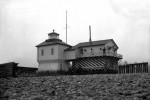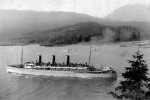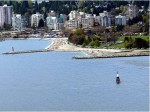– Dorothy Mawdsley (Harris) Harrop (daughter of first light keeper, George Alfred Harris, at Capilano 1913 – 1925) (with special thanks to Alfred Harrop, grandson of George Alfred Harris, for letting me post the text of the letter.)

[Father (George Alfred Harris)]. . . was given the First Narrows Light and Fog Station. I cannot remember but have a notion it was end of april 1915 when he took over. The light was first used May 17,1915 the day after my 17th birthday. The fog horn was started June 1, 1915.
It must have been rather hard him living there by himself. I do not know the dimensions of the lighthouse but it was full of engines. Two engines were the same and were there in case one broke down, then an air compressor which was linked with belts to pulleys from the engine to the wall and then up to a higher pulley and across to the compressor, hence by pipes to the fog horns.
Cannot remember how often it went but the people of West Vancouver called Point Atkinson the old cow and our horn the calf.
He had a small coal oil stove to cook on and had a canvas bag sort of affair with a single sized spring fitted into it and a mattress and his bedding.
In the day time this was pulled up to the ceiling and at night. If I remember rightly it rested on part of one of the engines and the small table he had to eat on. If it was foggy he could not have his bed down and used to cat nap sitting in an old wooden rocking chair with a high back with his feet on what ever was handy. Mother made some sort of a pad to go on the back of the chair because he was so thin the wooden rungs made his back sore. . .

I have forgotten all about the Light. Well from the engine room one climbed a ladder to the light and then dropped a trap door affair down. The lamp was a lovely brass lamp that held a certain amount of coal oil that would last so many hours. It was kept polished like a mirror.
Around the outside of the lamp was very thick glass. I don’t know how to describe that though. If I remember rightly there were 4 sections to these lenses and they were connected to a gadget that had to be wound up and it revolved slowly round to make an on and off appearance. Everything was cleaned and shone to perfection.
All this had to be set down in a sort of log, time lighted and time turned off. My father wrote a beautiful hand and I would dearly love to have the book that he kept the times in. Just like copper plate writing.
A separate book was kept for the on and off of the horn.

Around the top outside the light was a platform and the thick plate glass there was cleaned every day. The salt coated it when the wind blew or it rained and was streaky.
**********************************